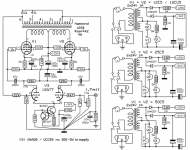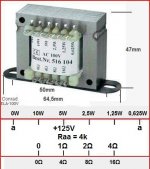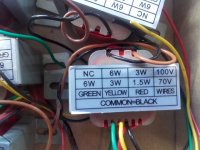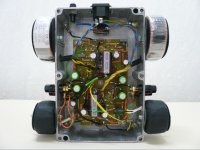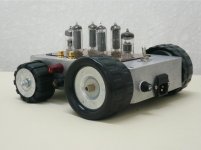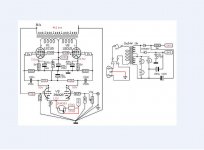As I mentioned over in the Introductions forum I have been thinking of getting into tubes through a project. A rather crazy project but if it wasn't a little crazy it wouldn't be as interesting.
The desired end product - A small boom box type system for listening to mp3s from bluetooth (or the headphone jack of a phone) while I'm working on other things. Currently I'm using generic computer speakers or simply the phone's speaker so I don't need hifi perfection. The initial plan was to do a mono speaker but I could be convinced to go stereo I guess.
The crazy complications -
I'm frugal bordering on cheap. Ideally I'd do this out of scavenged parts but I am currently in Korea (American teaching high school physics here) and my ability to look for deals at flea markets and junk sales is low.
I like offbeat things. Clearly I must or I wouldn't be thinking of a tube amp boombox. But in this case I mean that I've fallen for the idea of using either the space charge (and related) tubes from car radios or going with various 25v heater tubes that seem to be specced to run with B+ at or slightly over 100V. The first option naturally limits the output power to tiny amounts but is safe enough that I could get some of the students at school involved. The second option is just a silly compromise - high enough to be more dangerous but low enough to limit that tubes I can reasonably use. I told you I like offbeat things.
I'll put some inspirations and additional thoughts in a second post to avoid a wall of text.
The desired end product - A small boom box type system for listening to mp3s from bluetooth (or the headphone jack of a phone) while I'm working on other things. Currently I'm using generic computer speakers or simply the phone's speaker so I don't need hifi perfection. The initial plan was to do a mono speaker but I could be convinced to go stereo I guess.
The crazy complications -
I'm frugal bordering on cheap. Ideally I'd do this out of scavenged parts but I am currently in Korea (American teaching high school physics here) and my ability to look for deals at flea markets and junk sales is low.
I like offbeat things. Clearly I must or I wouldn't be thinking of a tube amp boombox. But in this case I mean that I've fallen for the idea of using either the space charge (and related) tubes from car radios or going with various 25v heater tubes that seem to be specced to run with B+ at or slightly over 100V. The first option naturally limits the output power to tiny amounts but is safe enough that I could get some of the students at school involved. The second option is just a silly compromise - high enough to be more dangerous but low enough to limit that tubes I can reasonably use. I told you I like offbeat things.
I'll put some inspirations and additional thoughts in a second post to avoid a wall of text.
[btw, please pardon following up to my own post. Some forums hate walls of text while others hate multiple posts]
Some random thoughts and inspirations in no particular order.
Sopht amps - Sopht schematics
The low end of my thoughts would be more or less a Sopht style guitar amp. The usage is basically desktop so I think the power would be enough at a meter or so. I have no experience with guitar amps so I'm not sure how bad it would sound compared to simply using my phone to play an mp3 directly.
Space Charge and Other Low-Voltage Tubes and Low Voltage Tubes.
Both sites have some ideas about using the audio tubes in non-guitar amps. Lots of dead links that need the wayback machine.
Bobs Bluetooth Lithium class D Boom-Box Project
The ultimate expression of what I want to do in a sense although he didn't restrict himself with tiny (30V or less) or small (around 110V) B+. I don't think I want to use this outside so I figure I don't need as much power either. Still, it is a beautiful looking project.
12V?d?? 12AE6-12CX6 2?????W?I
This looks like it might be pretty close to what I'd like to do. Too bad I don't read Japanese.
Now for the question I keep coming back to. How do you know how much gain you want? Assuming that I am going for either one or two gain stages and then a power stage into a transformer that is correctly sized for my speaker. The various low voltage space charge tetrodes say they can put out 35 or 40mW (some are even less). Does that mean I should aim for a mu of 40 given that I've seen people quote 1mW for headphone jacks?
If it matters my current plan is to use either a 12AE6 or 12AJ6 (three times the mu on the data sheet) then into a 12AL8 as both a triode and space charge tetrode for output. The link in Japanese above used the 12AE6 into a 12CX6 but I'm having a harder time finding out what to expect of tubes like the 12CN5, 12CX6, and 12CY6 as power stages.
Some random thoughts and inspirations in no particular order.
Sopht amps - Sopht schematics
The low end of my thoughts would be more or less a Sopht style guitar amp. The usage is basically desktop so I think the power would be enough at a meter or so. I have no experience with guitar amps so I'm not sure how bad it would sound compared to simply using my phone to play an mp3 directly.
Space Charge and Other Low-Voltage Tubes and Low Voltage Tubes.
Both sites have some ideas about using the audio tubes in non-guitar amps. Lots of dead links that need the wayback machine.
Bobs Bluetooth Lithium class D Boom-Box Project
The ultimate expression of what I want to do in a sense although he didn't restrict himself with tiny (30V or less) or small (around 110V) B+. I don't think I want to use this outside so I figure I don't need as much power either. Still, it is a beautiful looking project.
12V?d?? 12AE6-12CX6 2?????W?I
This looks like it might be pretty close to what I'd like to do. Too bad I don't read Japanese.
Now for the question I keep coming back to. How do you know how much gain you want? Assuming that I am going for either one or two gain stages and then a power stage into a transformer that is correctly sized for my speaker. The various low voltage space charge tetrodes say they can put out 35 or 40mW (some are even less). Does that mean I should aim for a mu of 40 given that I've seen people quote 1mW for headphone jacks?
If it matters my current plan is to use either a 12AE6 or 12AJ6 (three times the mu on the data sheet) then into a 12AL8 as both a triode and space charge tetrode for output. The link in Japanese above used the 12AE6 into a 12CX6 but I'm having a harder time finding out what to expect of tubes like the 12CN5, 12CX6, and 12CY6 as power stages.
Look at the low voltage amplifier designed by forum member Pilovis : Low Voltage (60V) Stereo Tube Amplifier for Dummies (2+2W)
This design does use a high current tube that does not need a real output transformer to get a nice low frequency response, and the power transformer is also cheap. It is possible to use different input tubes and power transformers. For instance, the UABC80 / 28AK8 tube does have a triode section that is electrically identical to 6SL7, and the filament does work about at the same voltage as the power tube PL504 / 27GB5. This will simplify the power supply section. It should be possible to build this circuit with other sweep tubes as well. I havent'built this amplifier yet, but it has been built successfully by several people already and the power output at low distortion level is a little bit less than 1W - this should be enough for your goal, I guess, if you use a high efficiency speaker.
This design does use a high current tube that does not need a real output transformer to get a nice low frequency response, and the power transformer is also cheap. It is possible to use different input tubes and power transformers. For instance, the UABC80 / 28AK8 tube does have a triode section that is electrically identical to 6SL7, and the filament does work about at the same voltage as the power tube PL504 / 27GB5. This will simplify the power supply section. It should be possible to build this circuit with other sweep tubes as well. I havent'built this amplifier yet, but it has been built successfully by several people already and the power output at low distortion level is a little bit less than 1W - this should be enough for your goal, I guess, if you use a high efficiency speaker.
That's a great call. I should have listed his build as another inspiration. I remember thinking that the idea of a stereo output that is simply two identical mono outputs (as far as I can tell) seems a little bit odd. Still it is clearly in the running as I start to nail down ideas.
You don’t really need to use exotic tubes. A pair of 12C5 or 12W6 ($3) in push pull will work fine into a 2 to 3k a-a load off 100-ish volts. And produce a couple of watts, not a fraction of a watt. A small center tapped power transformer of the appropriate voltage (10 or so volts CT) can be used as the output transformer. The little Antek toroids will work here, and have decent enough frequency response for this purpose. And they have appropriate power transformers at around the same price. That’s the cheapest way I know to get the iron. If you found an old line-operated hot chassis amp to cannibalize, it probably would have the right output transformers in it.
That's good to hear.
When I went back and looked at Pilovis's circuit today I had another reminder of why I bookmarked it but went to look at different options; I look from his circuit to the PL504 data sheet and I see little reason to assume it would make a good output. I believe that it does but I went looking for combinations of tubes where I could clearly see the reasoning for the selections.
When I went back and looked at Pilovis's circuit today I had another reminder of why I bookmarked it but went to look at different options; I look from his circuit to the PL504 data sheet and I see little reason to assume it would make a good output. I believe that it does but I went looking for combinations of tubes where I could clearly see the reasoning for the selections.
You certainly could use horizontal sweep tubes for outputs at low voltage, but you don’t have to be limited to them. A 12W6 and a socket cost less than a sweep tube, more expensive (compactron or magnoval) socket, and often a top cap. And draw half the heater current while still having useful plate current at 100 volt screen. Octal sweeps tend to command higher prices, but they do have some in the $5-6 range. The supply is dwindling. There are probably enough old “line operated radio” outputs around to keep tinkerers supplied for a while. Now if you wanted to make 50+ watts off of 200 or 300 volts, sweeps are the way to go.
You don’t really need to use exotic tubes. A pair of 12C5 or 12W6 ($3) in push pull will work fine into a 2 to 3k a-a load off 100-ish volts. And produce a couple of watts, not a fraction of a watt.
You are describing my second option better than I did. It really boils down to whether I get students involved. If I make it at school with students involved then I'll probably stick to a low voltage (48 or 50 DC) and be really scrounging for roughly 1 watt. If I keep the build at home then I'll likely go the route that you are describing and up the voltage to somewhere between 90-110. Since my specific needs don't require more that 2-5W I see no need to go higher.
A small center tapped power transformer of the appropriate voltage (10 or so volts CT) can be used as the output transformer. The little Antek toroids will work here, and have decent enough frequency response for this purpose. And they have appropriate power transformers at around the same price.
Transformers are turning out to be slightly more of a pain than I thought they would be. I'm currently in Korea and will be for a while. So I can get things cheaply from China but with all the hassles of not really knowing the quality. Anything hobby related that is here in Seoul is very expensive and shipping a transformer from the US is pretty steep. One option is to go all in at the few big electronics (including used and surplus) markets but my Korean isn't good enough to really get good deal.
Toriods look good although I need to settle a few more things before I can actually order one as I'd like to decide if I want to run the heater from the toroid or simply put a wall wart into the case.
Assuming I am going to get with a B+ larger than 50V I've been looking at a couple of different output options.
12C5, 12CA5, 12ED5, 12W6
The middle two have a bulk discount at vintagetubes.net which might be nice as I'm planning PP operation and will end up with 4 of whatever output I use.
If I went with a bigger heater I could use a 25C6 which might gain me a little but a 25V heater circuit looks like it would add needless complication compared to sticking a 14V wall wart plus a filter capacitor into the circuit. Other 25V options might work but are either expensive or have lower power (but also generally lower distortion).
12C5, 12CA5, 12ED5, 12W6
The middle two have a bulk discount at vintagetubes.net which might be nice as I'm planning PP operation and will end up with 4 of whatever output I use.
If I went with a bigger heater I could use a 25C6 which might gain me a little but a 25V heater circuit looks like it would add needless complication compared to sticking a 14V wall wart plus a filter capacitor into the circuit. Other 25V options might work but are either expensive or have lower power (but also generally lower distortion).
If I were in that part of the world I’d be looking at China too. Since you’re not looking for the end all be all in quality - just something acceptable. Does anybody know where Antek really gets them made? I don’t think they actually wind them in-house. If they did that in New England, a $57 unit would cost $500 (and you would be able to get out of stock models in 6 weeks).
In general, getting the iron is the biggest pain in the tail, and most expensive part of building any tube amp. Most of my tube tinkering is related to what iron I can get for cheap - the only exception being a big 200 watt per channel build I’m working on now. Even then I set a strict price limit, which meant Hammond was as high as I’d go for an OPT. Other projects are built around what I can scrounge - and I’m not afraid to do a little rewinding. Even then you still have to get a core or donor transformer. Getting cores might even be easier from China - I’ve never looked into it. Cost prohibitive from more “reputable” sources, especially for projects like this.
In general, getting the iron is the biggest pain in the tail, and most expensive part of building any tube amp. Most of my tube tinkering is related to what iron I can get for cheap - the only exception being a big 200 watt per channel build I’m working on now. Even then I set a strict price limit, which meant Hammond was as high as I’d go for an OPT. Other projects are built around what I can scrounge - and I’m not afraid to do a little rewinding. Even then you still have to get a core or donor transformer. Getting cores might even be easier from China - I’ve never looked into it. Cost prohibitive from more “reputable” sources, especially for projects like this.
It depends.
maybe a 70V or 100V line transformer might fit the requirements for a cheap OPT for a push pull amp?
If expectations are a less hifi more restricted bandwidth, less bass...
At low powers I have been impressed with small toroids, but I havent had luck with larger VA - although that's my experience, and I believe plenty have made good use of larger VA size toroids
maybe a 70V or 100V line transformer might fit the requirements for a cheap OPT for a push pull amp?
If expectations are a less hifi more restricted bandwidth, less bass...
At low powers I have been impressed with small toroids, but I havent had luck with larger VA - although that's my experience, and I believe plenty have made good use of larger VA size toroids
Long time ago i proposed a low voltage amp.It was build by a forum member with toroidal outputs, not the Hammonds i proposed.With the four tansformers it looked like a car with the toroids as wheels.
But you could also use 100V line transformers as mondogenerator pointed out.
Here the schematic (a bit more simple then the original) with supplys for different possible tubes.And also how to use a line transformer.
If the amp oscillates invert the anode connections of the output tubes.
That is because there is no indication witch connection is the start of the winding.
Mona
But you could also use 100V line transformers as mondogenerator pointed out.
Here the schematic (a bit more simple then the original) with supplys for different possible tubes.And also how to use a line transformer.
If the amp oscillates invert the anode connections of the output tubes.
That is because there is no indication witch connection is the start of the winding.
Mona
Attachments
That looks, at least at a first glance, rather close to my first pass at a design. I'll post a schematic later (perhaps this weekend) after I get something that looks neat and organized in LTSpice. I like the confirmation that a the 12AT6 by itself is enough to drive the 12C5.
Not for push pull. The power taps need to be related by a factor of 4 to make a center tapped transformer. You might be able to get away with single ended operation at a low enough DC bias. Some line matching transformers tolerate this, others just saturate.
In post 12, the last tap is off by one position but it’s the right idea.
In post 12, the last tap is off by one position but it’s the right idea.
Yes, you are right, the center tap is 2,5WIn post 12, the last tap is off by one position but it’s the right idea.

Mona
Long time ago i proposed a low voltage amp.It was build by a forum member with toroidal outputs, not the Hammonds i proposed.With the four tansformers it looked like a car with the toroids as wheels.
But you could also use 100V line transformers as mondogenerator pointed out.
Here the schematic (a bit more simple then the original) with supplys for different possible tubes.And also how to use a line transformer.
If the amp oscillates invert the anode connections of the output tubes.
That is because there is no indication witch connection is the start of the winding.
Mona
Really small but speedy and lots of grip.
I used this for OPT: Toroidal Transformer for audio: Out ~11V/0.55A; Input ~100/110/120/220/230/240V | eBay I had to reduce feedback to make it stable. Frequency response is nothing like flat but it does the full audio spectrum. Given the purpose being radio listening afterhours, this is a very nice sounding little amp.
PS. I just remembered the very first test of this amp connected to my 94dB/W/m open baffles. I thought to make it easy and chose Ry Cooder's "Paris-Texas". It made it clear once and for all that it's only small to the eye!
Attachments
I love the wheels!
I'm bad about over analyzing choices so I'm going to post a few transformers to get some feedback.
A rather sketchy looking one - the pictures make you think pair but I think the price quoted is for one
10k to 8Ohm that keeps coming up in searchs. That impedance is too high for the output tubes I want to use though
Pair of 8k, push pull, 5W transformers for $32 plus shipping seems like a winner
Sorry for asking people to translate a page but am I missing some big gotcha with that pair?
I'm bad about over analyzing choices so I'm going to post a few transformers to get some feedback.
A rather sketchy looking one - the pictures make you think pair but I think the price quoted is for one
10k to 8Ohm that keeps coming up in searchs. That impedance is too high for the output tubes I want to use though
Pair of 8k, push pull, 5W transformers for $32 plus shipping seems like a winner
Sorry for asking people to translate a page but am I missing some big gotcha with that pair?
Another option that keeps showing up are toroidal transformers sealed in metal housings with resin. For example ...
Product Name: with shield potting transformer 30W double 15V+9V
Product outer dimensions: diameter: 82MM, height 40MM
Input voltage: AC0-110-220V three-wire,
Output: AC15V-0-15V three wires, AC0-9V 2 wires
Power: 30W
Net weight: 0.75KG/PCS
It's been ages since I've dealt seriously with AC so I'm rusty on transformers but it looks like I could use it as a CT with a voltage ratio of 220:9. That should give a Z ratio of roughly 600 (or 215 if you use the other output). Has anyone experimented to see just how bad these are?
Product Name: with shield potting transformer 30W double 15V+9V
Product outer dimensions: diameter: 82MM, height 40MM
Input voltage: AC0-110-220V three-wire,
Output: AC15V-0-15V three wires, AC0-9V 2 wires
Power: 30W
Net weight: 0.75KG/PCS
It's been ages since I've dealt seriously with AC so I'm rusty on transformers but it looks like I could use it as a CT with a voltage ratio of 220:9. That should give a Z ratio of roughly 600 (or 215 if you use the other output). Has anyone experimented to see just how bad these are?
I have found that many 70V or 100V line transformers have a mid band resonance or efficiency centred about 2kHz, when I have tried then for a SET parallel feed OPT. The DC blocking capacitor, in that case may need to be larger. I didnt stay with that particular toroid long. I found smaller (5VA or less) toroids worked better in what was a headphone amplifier.
Mentioning that, there is another option open to the OP, possibly.
Can parallel feed be used for push pull stages? I've never tried.
But it may be another option.
Mentioning that, there is another option open to the OP, possibly.
Can parallel feed be used for push pull stages? I've never tried.
But it may be another option.
- Status
- This old topic is closed. If you want to reopen this topic, contact a moderator using the "Report Post" button.
- Home
- Amplifiers
- Tubes / Valves
- Workshop Audio Project - low power intro to playing with tubes
